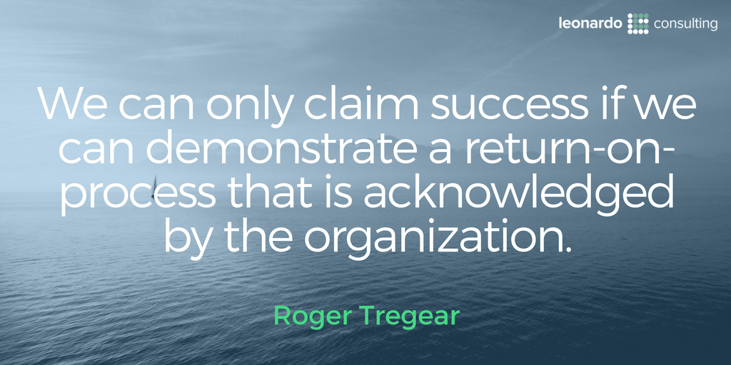 It proves to be easy for those closely involved in the theory and practice of process-based management to confuse the delivery of nicely crafted artifacts with delivering real value. We can too easily get wrapped up in the development of the (very necessary) diagrams, models, spreadsheets, presentations, posters, methodologies, information databases, role descriptions, modeling conventions, project plans, and the many other realizations of business process performance and concepts, and lose sight of the real purpose.
It proves to be easy for those closely involved in the theory and practice of process-based management to confuse the delivery of nicely crafted artifacts with delivering real value. We can too easily get wrapped up in the development of the (very necessary) diagrams, models, spreadsheets, presentations, posters, methodologies, information databases, role descriptions, modeling conventions, project plans, and the many other realizations of business process performance and concepts, and lose sight of the real purpose.
What is that ‘real purpose’? This might seem like a trivial question, but the answer is important, and too many process practitioners, and the teams in which they work, do not have a clear answer—or if they do, it gets lost in the daily pressures of work.
The only ‘real purpose’ that makes sense is to contribute in meaningful ways to the improvement of organizational performance. If we are not doing that, then we are waste by our own definitions.
The need to meet commitments to deliver various artifacts can easily overwhelm the what should be the clear overall objective, our focus narrows to getting the next document completed, we focus on getting business units to use the methodology properly, or to complete the required report, or turn up to the process review workshop, or to comply with modeling conventions—in short, we lose the cross-functional view that we evangelize to others. Oops! That’s more than a little embarrassing.
This contribution to sustained performance improvement must be proven, not just asserted. As process practitioners, we are part of the cross-functional team that executes the process 'improve performance', and that process must also be measured, managed, and improved in the same way we advocate for all other processes. This process must be the best managed and highest performing process in any organization.
We can’t say we are doing well and increasing our process management maturity, because we have created a thousand artifacts (diagrams, models, charts etc.) We can only claim success if we can demonstrate a return-on-process that is acknowledged by the organization.
Perhaps the real test is that, come budget time, the process group is offered more money because it is seen to be a good investment.
This is not to say that the artifacts of process management and improvement are not important. Of course, they are, but they must be a means to an end. When we get too close to them we lose the fundamental idea that process-based management must be about management. The M in BPM is for management, not modeling.
For any process, this is the important sequence of analysis questions:
- What are the critical few measures of process performance?
- How should the process perform?
- How is the process performing?
- Are the process performance gaps worth closing?
- How could the gaps be closed?
- What benefits would come from such changes?
- Did it work?
Yes, you need the right tools and techniques to do this well, but the most important question is the last one—did it work, can we prove that we have improved organizational performance?
If you work in or near a central process support group, make a list of what they produce. That list will include plenty of the usual process artifacts. Now imagine that each of those artifacts disappeared. How would the organization suffer? Who would notice? This is a tough test, but it must be the one we apply on a regular basis
It’s tough test that process support groups can pass, but it won’t happen automatically. There must be a clear goal and deliberate action to make a positive difference in proven, accepted business terms. I have suggested previously that process-based management is 90% mindset and 10% toolset. That mindset must be strongest and most developed in a central support group if we are to relentlessly focus on ‘process value’ and avoid being distracted by ‘process things’. It requires a concerted effort to develop, evolve, and maintain process thinking. This is not going to happen without assiduous effort, and it’s not a one-off exercise.




